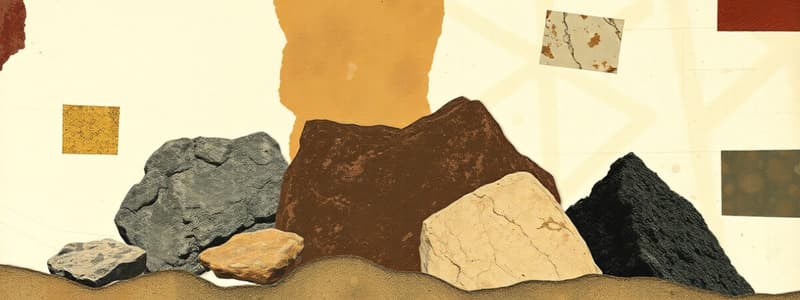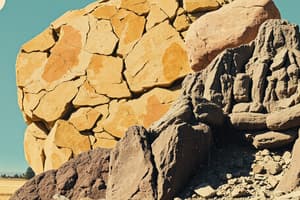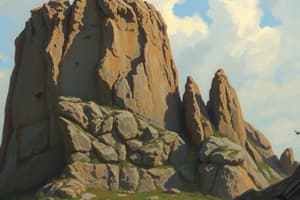Podcast
Questions and Answers
What term describes the chemical breakdown of rocks and contributes to soil formation?
What term describes the chemical breakdown of rocks and contributes to soil formation?
Weathering
Identify the primary source material of peat and its ecological significance.
Identify the primary source material of peat and its ecological significance.
Remains of dead plants and animals
What type of rock, characterized by its coarse grain, originates from the cooling of magma beneath the earth's surface?
What type of rock, characterized by its coarse grain, originates from the cooling of magma beneath the earth's surface?
Granite
Explain the significance of freeze-thaw action in geological processes.
Explain the significance of freeze-thaw action in geological processes.
What is the transformation process of limestone into another rock type, and what is the resulting rock?
What is the transformation process of limestone into another rock type, and what is the resulting rock?
Discuss the role of erosion and deposition in sedimentary rock formation.
Discuss the role of erosion and deposition in sedimentary rock formation.
Contrast the fertility sources of young soil versus old soil.
Contrast the fertility sources of young soil versus old soil.
How does topography influence soil formation and its consequent characteristics?
How does topography influence soil formation and its consequent characteristics?
Explain the differences in nutrient holding capacity between grassland and forest ecosystems.
Explain the differences in nutrient holding capacity between grassland and forest ecosystems.
What is the consequence of soil erosion for agricultural practices?
What is the consequence of soil erosion for agricultural practices?
What process leads to the physical breakdown of rocks through temperature changes?
What process leads to the physical breakdown of rocks through temperature changes?
What organic components primarily constitute peat?
What organic components primarily constitute peat?
What type of soil is characterized by high nutrient holding capacity due to trees?
What type of soil is characterized by high nutrient holding capacity due to trees?
Which rock type is typically produced from the cooling of magma that erupts on the surface?
Which rock type is typically produced from the cooling of magma that erupts on the surface?
Identify the primary mineral that makes up limestone.
Identify the primary mineral that makes up limestone.
How does sedimentary rock formation occur?
How does sedimentary rock formation occur?
What are the three main characteristics of soil?
What are the three main characteristics of soil?
What is the difference in parent material availability between young and old soil?
What is the difference in parent material availability between young and old soil?
Which metamorphic rock is created from the alteration of limestone?
Which metamorphic rock is created from the alteration of limestone?
What effect does soil erosion have on agricultural productivity?
What effect does soil erosion have on agricultural productivity?
What is the process that leads to the physical breakdown of rocks due to temperature fluctuations?
What is the process that leads to the physical breakdown of rocks due to temperature fluctuations?
What is the geological term for the organic material found in peat?
What is the geological term for the organic material found in peat?
Which type of soil is predominantly formed in areas with high moisture and low decomposition rates?
Which type of soil is predominantly formed in areas with high moisture and low decomposition rates?
Identify the rock type that is formed from the cooling of magma on the Earth's surface.
Identify the rock type that is formed from the cooling of magma on the Earth's surface.
What geological process involves the removal and transportation of topsoil?
What geological process involves the removal and transportation of topsoil?
Which metamorphic rock is derived from the transformation of shale?
Which metamorphic rock is derived from the transformation of shale?
What is the primary difference in nutrient sources between young soil and old soil?
What is the primary difference in nutrient sources between young soil and old soil?
What type of soil is typically associated with high nutrient retention due to tree cover?
What type of soil is typically associated with high nutrient retention due to tree cover?
How does the process of erosion and deposition contribute to the formation of sedimentary rocks?
How does the process of erosion and deposition contribute to the formation of sedimentary rocks?
What is the implication of having limited parent material in old soil regarding its fertility?
What is the implication of having limited parent material in old soil regarding its fertility?
Flashcards are hidden until you start studying
Study Notes
Weathering and Rock Types
- Weathering is the chemical breakdown process of rocks.
- Parent material of peat consists of remains of dead plants and animals.
- Granite is an igneous rock formed from the cooling of magma below ground.
- Basalt is another igneous rock commonly found in volcanic activity.
- Limestone serves as the primary mineral source for calcium carbonate.
Sedimentary and Metamorphic Rocks
- Sedimentary rocks are formed through processes of erosion and deposition.
- Sandstone is a type of sedimentary rock composed of sand-sized grains.
- Marble is the metamorphic rock that originates from limestone.
- Slate is a metamorphic rock formed from shale.
Soil Characteristics and Formation
- Soil characteristics include texture, pH, and drainage.
- Young soil obtains fertility from rock minerals and organic matter; old soil relies mainly on organic matter.
- Forests contribute significantly to soil nutrient holding capacity due to trees' ability to retain nutrients.
- Topography influences soil formation, particularly affecting erosion rates.
- Availability of parent material is critical; young soil has abundant parent material, whereas old soil has diminished availability.
- Grassland ecosystems exhibit a lower nutrient holding capacity compared to forests.
Impact of Soil Erosion
- Soil erosion negatively affects fertility by removing nutrient-rich topsoil, which is vital for plant growth.
Weathering and Rock Types
- Weathering is the chemical breakdown process of rocks.
- Parent material of peat consists of remains of dead plants and animals.
- Granite is an igneous rock formed from the cooling of magma below ground.
- Basalt is another igneous rock commonly found in volcanic activity.
- Limestone serves as the primary mineral source for calcium carbonate.
Sedimentary and Metamorphic Rocks
- Sedimentary rocks are formed through processes of erosion and deposition.
- Sandstone is a type of sedimentary rock composed of sand-sized grains.
- Marble is the metamorphic rock that originates from limestone.
- Slate is a metamorphic rock formed from shale.
Soil Characteristics and Formation
- Soil characteristics include texture, pH, and drainage.
- Young soil obtains fertility from rock minerals and organic matter; old soil relies mainly on organic matter.
- Forests contribute significantly to soil nutrient holding capacity due to trees' ability to retain nutrients.
- Topography influences soil formation, particularly affecting erosion rates.
- Availability of parent material is critical; young soil has abundant parent material, whereas old soil has diminished availability.
- Grassland ecosystems exhibit a lower nutrient holding capacity compared to forests.
Impact of Soil Erosion
- Soil erosion negatively affects fertility by removing nutrient-rich topsoil, which is vital for plant growth.
Weathering and Rock Types
- Weathering is the chemical breakdown process of rocks.
- Parent material of peat consists of remains of dead plants and animals.
- Granite is an igneous rock formed from the cooling of magma below ground.
- Basalt is another igneous rock commonly found in volcanic activity.
- Limestone serves as the primary mineral source for calcium carbonate.
Sedimentary and Metamorphic Rocks
- Sedimentary rocks are formed through processes of erosion and deposition.
- Sandstone is a type of sedimentary rock composed of sand-sized grains.
- Marble is the metamorphic rock that originates from limestone.
- Slate is a metamorphic rock formed from shale.
Soil Characteristics and Formation
- Soil characteristics include texture, pH, and drainage.
- Young soil obtains fertility from rock minerals and organic matter; old soil relies mainly on organic matter.
- Forests contribute significantly to soil nutrient holding capacity due to trees' ability to retain nutrients.
- Topography influences soil formation, particularly affecting erosion rates.
- Availability of parent material is critical; young soil has abundant parent material, whereas old soil has diminished availability.
- Grassland ecosystems exhibit a lower nutrient holding capacity compared to forests.
Impact of Soil Erosion
- Soil erosion negatively affects fertility by removing nutrient-rich topsoil, which is vital for plant growth.
Studying That Suits You
Use AI to generate personalized quizzes and flashcards to suit your learning preferences.




